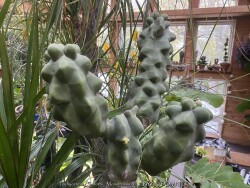

Pachycereus Schottii (Pachycereus schottii f. monstrosus) is native to the desert regions of mainland Mexico and the Baja California peninsula of Mexico. The monstrous form is restricted to a small area about halfway down the Baja peninsula. In the wild, established plants are hardy to about 25 degrees F for short periods of time. Totem pole cacti are usually grown as a patio or house plant in Kansas. Grow in full sun with occasional extra watering including that which comes from rainfall. Repotting may or may not be needed depending on how large you want the plant to grow; plants can continue to grow taller and tolerate extremely root-bound pots but may need wind bracing. If repotting, make sure to use a sharp draining medium organic cactus mix with plenty of sand and perlite. To play is safe, potted plants are best moved in before night temperatures get below 45 degrees F. It is important to avoid the combination of wet and cold. Before extreme cold occurs, move to a bright interior window over the winter with no watering and keep above freezing. As a winter house plant, it will look presentable all winter long with no waterings.(also to prevent lanky winter growth) As a permanent house plant, provide bright light and allow the soil to dry between waterings for many years of carefree enjoyment. Plants grown permanently indoors may begin to elongate stretching for light and lose their spine color. It can be hard to reproduce the intense UV sunlight they need so moving outside for the summer is best. Generally if moving outside for the summer, allow 1-2 weeks of part shade or morning sun before placing in full sun. Plants with time to acclimate will thrive in full hot sun but be careful not to rush it or sunburning can occur. Potted plants are very low maintenance. I have never seen any insect problems on this plant. Pachycereus schottii f. monstrosus is the most attractive monstrous form with pronounced knobby tubercles and smooth green skin; it is rare and will command a higher price than most other houseplants. Another naturally occuring monstrous form, Pachycereus schottii f. mieckleyanus, also has smooth green skin but thinner stems with less tubercles.
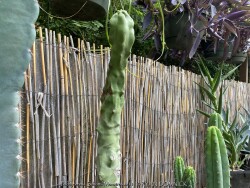

Pachycereus Schottii (Pachycereus schottii f. monstrosus) is native to the desert regions of mainland Mexico and the Baja California peninsula of Mexico. The monstrous form is restricted to a small area about halfway down the Baja peninsula. In the wild, established plants are hardy to about 25 degrees F for short periods of time. Totem pole cacti are usually grown as a patio or house plant in Kansas. Grow in full sun with occasional extra watering including that which comes from rainfall. Repotting may or may not be needed depending on how large you want the plant to grow; plants can continue to grow taller and tolerate extremely root-bound pots but may need wind bracing. If repotting, make sure to use a sharp draining medium organic cactus mix with plenty of sand and perlite. To play is safe, potted plants are best moved in before night temperatures get below 45 degrees F. It is important to avoid the combination of wet and cold. Before extreme cold occurs, move to a bright interior window over the winter with no watering and keep above freezing. As a winter house plant, it will look presentable all winter long with no waterings.(also to prevent lanky winter growth) As a permanent house plant, provide bright light and allow the soil to dry between waterings for many years of carefree enjoyment. Plants grown permanently indoors may begin to elongate stretching for light and lose their spine color. It can be hard to reproduce the intense UV sunlight they need so moving outside for the summer is best. Generally if moving outside for the summer, allow 1-2 weeks of part shade or morning sun before placing in full sun. Plants with time to acclimate will thrive in full hot sun but be careful not to rush it or sunburning can occur. Potted plants are very low maintenance. I have never seen any insect problems on this plant. There are 2 or more forms. Compared to Pachycereus schottii f. monstrosus, Pachycereus schottii f. mieckleyanus (Pachycereus schottii f. monstrosus 'Minor'), has smooth green skin but thinner stems with less tubercles. This form is faster growing.
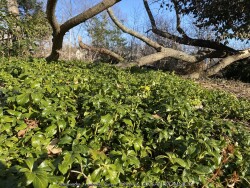

***Description for this perennial available with future update!***Green Sheen Japanese Pachysandra, is also known as Pachysandra terminalis 'Green Sheen'
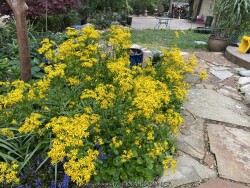

***Description for this perennial available with future update!***Native Roundleaf Groundsel / Packera, is also known as Packera obovata
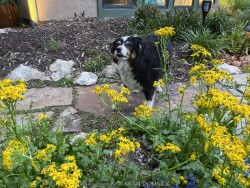

***Description for this perennial available with future update!***Native Roundleaf Groundsel / Packera, is also known as Packera obovata
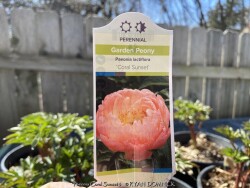

Peonies (Paeonia), along with roses are one of the most universally well-known flowers. The toughness and durability of this plant can be seen in cemeteries or around abandoned houses, surviving decades even 100 years or more without care. Peonies are native to China in cold continental climate areas but also do well in Kansas. Large flowers come in different shades of white, red, and pink. Peonies bloom usually around Memorial Day hence their popularity and cemeteries. Blooming lasts about 2 weeks but can be short-lived if a thunderstorm happens during the last week of blooming when petals are fully open. In zone 6 and south, the foliage is glossy green and attractive throughout the first half of summer. Usually, by late summer, foliage is tattered from drought stress and diseases. This has no ill effect on the health of the plant as it is already set its growth buds for next year. In northern areas (USDA zones 3-5), Peony foliage lasts all summer and turns a brilliant red and orange color in the fall. Due to its need for cold winters, peonies will not grow well further south than zone 8b. Gardeners in south Florida have had success getting peonies to bloom by dumping a bag of ice on the dormant plant every day for 5-6 weeks in winter: sounds like a lot of work huh! Due to its cold tolerance, peonies may be grown in above-ground pots or raised planters year-round. When planting outside, be careful to plant at the correct depth with pink buds slightly below the soil or plants will not bloom. Overall, peonies are a very reliable long-lived plant in Kansas surviving everything. But they do require some maintenance to look their best. Ultra cold-hardy plants from northern climates normally dislike our long hot humid summers; although we are on the Southern edge of this plant's adaptability, it still survives reasonably well here. Look for a cold microclimate planting location such as East or North exposure. Paeonia 'Coral Sunset' features double flowering multi-colored (Pink,Salmon,Peach,Gold) blooms.


Peonies (Paeonia), along with roses are one of the most universally well-known flowers. The toughness and durability of this plant can be seen in cemeteries or around abandoned houses, surviving decades even 100 years or more without care. Peonies are native to China in cold continental climate areas but also do well in Kansas. Large flowers come in different shades of white, red, and pink. Peonies bloom usually around Memorial Day hence their popularity and cemeteries. Blooming lasts about 2 weeks but can be short-lived if a thunderstorm happens during the last week of blooming when petals are fully open. In zone 6 and south, the foliage is glossy green and attractive throughout the first half of summer. Usually, by late summer, foliage is tattered from drought stress and diseases. This has no ill effect on the health of the plant as it is already set its growth buds for next year. In northern areas (USDA zones 3-5), Peony foliage lasts all summer and turns a brilliant red and orange color in the fall. Due to its need for cold winters, peonies will not grow well further south than zone 8b. Gardeners in south Florida have had success getting peonies to bloom by dumping a bag of ice on the dormant plant every day for 5-6 weeks in winter: sounds like a lot of work huh! Due to its cold tolerance, peonies may be grown in above-ground pots or raised planters year-round. When planting outside, be careful to plant at the correct depth with pink buds slightly below the soil or plants will not bloom. Overall, peonies are a very reliable long-lived plant in Kansas surviving everything. But they do require some maintenance to look their best. Ultra cold-hardy plants from northern climates normally dislike our long hot humid summers; although we are on the Southern edge of this plant's adaptability, it still survives reasonably well here. Look for a cold microclimate planting location such as East or North exposure. Peony 'Flame' features single flowering red blooms displayed on the bold erect stems.
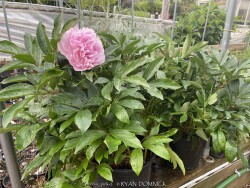

Peonies (Paeonia), along with roses are one of the most universally well-known flowers. The toughness and durability of this plant can be seen in cemeteries or around abandoned houses, surviving decades even 100 years or more without care. Peonies are native to China in cold continental climate areas but also do well in Kansas. Large flowers come in different shades of white, red, and pink. Peonies bloom usually around Memorial Day hence their popularity and cemeteries. Blooming lasts about 2 weeks but can be short-lived if a thunderstorm happens during the last week of blooming when petals are fully open. In zone 6 and south, the foliage is glossy green and attractive throughout the first half of summer. Usually, by late summer, foliage is tattered from drought stress and diseases. This has no ill effect on the health of the plant as it is already set its growth buds for next year. In northern areas (USDA zones 3-5), Peony foliage lasts all summer and turns a brilliant red and orange color in the fall. Due to its need for cold winters, peonies will not grow well further south than zone 8b. Gardeners in south Florida have had success getting peonies to bloom by dumping a bag of ice on the dormant plant every day for 5-6 weeks in winter: sounds like a lot of work huh! Due to its cold tolerance, peonies may be grown in above-ground pots or raised planters year-round. When planting outside, be careful to plant at the correct depth with pink buds slightly below the soil or plants will not bloom. Overall, peonies are a very reliable long-lived plant in Kansas surviving everything. But they do require some maintenance to look their best. Ultra cold-hardy plants from northern climates normally dislike our long hot humid summers; although we are on the Southern edge of this plant's adaptability, it still survives reasonably well here. Look for a cold microclimate planting location such as East or North exposure.
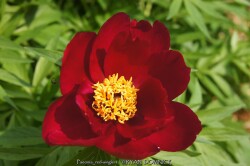

Peonies (Paeonia), along with roses are one of the most universally well-known flowers. The toughness and durability of this plant can be seen in cemeteries or around abandoned houses, surviving decades even 100 years or more without care. Peonies are native to China in cold continental climate areas but also do well in Kansas. Large flowers come in different shades of white, red, and pink. Peonies bloom usually around Memorial Day hence their popularity and cemeteries. Blooming lasts about 2 weeks but can be short-lived if a thunderstorm happens during the last week of blooming when petals are fully open. In zone 6 and south, the foliage is glossy green and attractive throughout the first half of summer. Usually, by late summer, foliage is tattered from drought stress and diseases. This has no ill effect on the health of the plant as it is already set its growth buds for next year. In northern areas (USDA zones 3-5), Peony foliage lasts all summer and turns a brilliant red and orange color in the fall. Due to its need for cold winters, peonies will not grow well further south than zone 8b. Gardeners in south Florida have had success getting peonies to bloom by dumping a bag of ice on the dormant plant every day for 5-6 weeks in winter: sounds like a lot of work huh! Due to its cold tolerance, peonies may be grown in above-ground pots or raised planters year-round. When planting outside, be careful to plant at the correct depth with pink buds slightly below the soil or plants will not bloom. Overall, peonies are a very reliable long-lived plant in Kansas surviving everything. But they do require some maintenance to look their best. Ultra cold-hardy plants from northern climates normally dislike our long hot humid summers; although we are on the Southern edge of this plant's adaptability, it still survives reasonably well here. Look for a cold microclimate planting location such as East or North exposure.


Peonies (Paeonia), along with roses are one of the most universally well-known flowers. The toughness and durability of this plant can be seen in cemeteries or around abandoned houses, surviving decades even 100 years or more without care. Peonies are native to China in cold continental climate areas but also do well in Kansas. Large flowers come in different shades of white, red, and pink. Peonies bloom usually around Memorial Day hence their popularity and cemeteries. Blooming lasts about 2 weeks but can be short-lived if a thunderstorm happens during the last week of blooming when petals are fully open. In zone 6 and south, the foliage is glossy green and attractive throughout the first half of summer. Usually, by late summer, foliage is tattered from drought stress and diseases. This has no ill effect on the health of the plant as it is already set its growth buds for next year. In northern areas (USDA zones 3-5), Peony foliage lasts all summer and turns a brilliant red and orange color in the fall. Due to its need for cold winters, peonies will not grow well further south than zone 8b. Gardeners in south Florida have had success getting peonies to bloom by dumping a bag of ice on the dormant plant every day for 5-6 weeks in winter: sounds like a lot of work huh! Due to its cold tolerance, peonies may be grown in above-ground pots or raised planters year-round. When planting outside, be careful to plant at the correct depth with pink buds slightly below the soil or plants will not bloom. Overall, peonies are a very reliable long-lived plant in Kansas surviving everything. But they do require some maintenance to look their best. Ultra cold-hardy plants from northern climates normally dislike our long hot humid summers; although we are on the Southern edge of this plant's adaptability, it still survives reasonably well here. Look for a cold microclimate planting location such as East or North exposure. Paeonia lactiflora 'Kansas' features double flowering magenta-carmine-red blooms are displayed on the bold, erect stems.
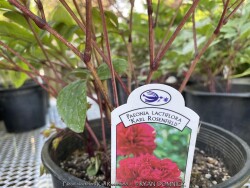

Peonies (Paeonia), along with roses are one of the most universally well-known flowers. The toughness and durability of this plant can be seen in cemeteries or around abandoned houses, surviving decades even 100 years or more without care. Peonies are native to China in cold continental climate areas but also do well in Kansas. Large flowers come in different shades of white, red, and pink. Peonies bloom usually around Memorial Day hence their popularity and cemeteries. Blooming lasts about 2 weeks but can be short-lived if a thunderstorm happens during the last week of blooming when petals are fully open. In zone 6 and south, the foliage is glossy green and attractive throughout the first half of summer. Usually, by late summer, foliage is tattered from drought stress and diseases. This has no ill effect on the health of the plant as it is already set its growth buds for next year. In northern areas (USDA zones 3-5), Peony foliage lasts all summer and turns a brilliant red and orange color in the fall. Due to its need for cold winters, peonies will not grow well further south than zone 8b. Gardeners in south Florida have had success getting peonies to bloom by dumping a bag of ice on the dormant plant every day for 5-6 weeks in winter: sounds like a lot of work huh! Due to its cold tolerance, peonies may be grown in above-ground pots or raised planters year-round. When planting outside, be careful to plant at the correct depth with pink buds slightly below the soil or plants will not bloom. Overall, peonies are a very reliable long-lived plant in Kansas surviving everything. But they do require some maintenance to look their best. Ultra cold-hardy plants from northern climates normally dislike our long hot humid summers; although we are on the Southern edge of this plant's adaptability, it still survives reasonably well here. Look for a cold microclimate planting location such as East or North exposure. Paeonia lactiflora 'Karl Rosenfield' features double flowering red to shades of magenta-carmine-reddish blooms that are displayed on the bold, erect stems.
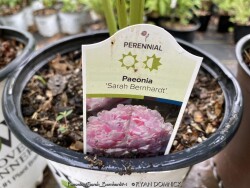

Peonies (Paeonia), along with roses are one of the most universally well-known flowers. The toughness and durability of this plant can be seen in cemeteries or around abandoned houses, surviving decades even 100 years or more without care. Peonies are native to China in cold continental climate areas but also do well in Kansas. Large flowers come in different shades of white, red, and pink. Peonies bloom usually around Memorial Day hence their popularity and cemeteries. Blooming lasts about 2 weeks but can be short-lived if a thunderstorm happens during the last week of blooming when petals are fully open. In zone 6 and south, the foliage is glossy green and attractive throughout the first half of summer. Usually, by late summer, foliage is tattered from drought stress and diseases. This has no ill effect on the health of the plant as it is already set its growth buds for next year. In northern areas (USDA zones 3-5), Peony foliage lasts all summer and turns a brilliant red and orange color in the fall. Due to its need for cold winters, peonies will not grow well further south than zone 8b. Gardeners in south Florida have had success getting peonies to bloom by dumping a bag of ice on the dormant plant every day for 5-6 weeks in winter: sounds like a lot of work huh! Due to its cold tolerance, peonies may be grown in above-ground pots or raised planters year-round. When planting outside, be careful to plant at the correct depth with pink buds slightly below the soil or plants will not bloom. Overall, peonies are a very reliable long-lived plant in Kansas surviving everything. But they do require some maintenance to look their best. Ultra cold-hardy plants from northern climates normally dislike our long hot humid summers; although we are on the Southern edge of this plant's adaptability, it still survives reasonably well here. Look for a cold microclimate planting location such as East or North exposure. Paeonia lactiflora 'Sarah Bernhardt' features enormous, fragrant, double flowers in rose pink with white edges.
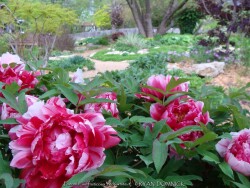

Tree Peonies (Paeonia suffruiticosa) are larger, woody relatives of the common herbaceous (perennial) peony. It does not die to the ground each winter, instead growing up to 3-5 feet after many years. Tree peonies have been in culture in China for millennia. Most "tree" peonies are really just shrubs and are grafted to the rootstock of herbaceous peonies. Peonies, along with roses are one of the most universally well-known flowers. The toughness and durability of this plant can be seen in cemeteries or around abandoned houses, surviving decades even 100 years or more without care. Both tree and herbaceous peonies are native to China in cold continental climate areas but also do well in Kansas. Large flowers come in different shades of white, red, and pink. Blooming only lasts about 3-7 days and can be short-lived if a thunderstorm happens during the second day of blooming when petals are fully open. The foliage is especially attractive in spring when unfurling into a flat, rich green and remains attractive throughout summer. Usually, by early fall, foliage is tattered from drought stress and diseases with no appreciable fall color. This has no ill effect on the health of the plant as it is already set its growth buds for next year. In northern areas (USDA zones 3-6), Peony foliage lasts all summer and turns brilliant red and orange colors in the fall. Due to its need for cold winters, peonies will not grow well further south than zone 8b. Due to its cold tolerance, peonies may be grown in above-ground pots or raised planters year-round. Ultra cold-hardy plants from northern climates normally dislike our long hot humid summers; although we are on the Southern edge of this plant's adaptability, it still survives reasonably well here. Several have been alive for over 15 years and bloom like clockwork each spring here in our Lawrence, KS display garden.
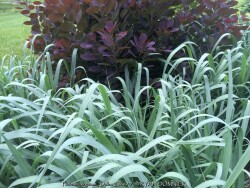

***Description for this grass available with future update!***Dallas Blues Switch Grass, is also known as Panicum virgatum 'Dallas Blues'
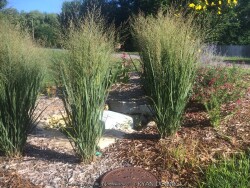

***Description for this grass available with future update!***Northwinds Switch Grass, is also known as Panicum virgatum 'Northwinds'
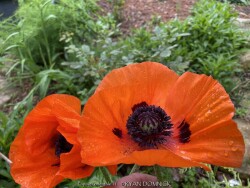

***Description for this perennial available with future update!*** Papaver orientale is also known as Orange Oriental Poppy >>>>>Ultra cold-hardy plants from northern climates normally dislike our long hot humid summers; although we are on the Southern edge of this plants adaptability, it still survives reasonably well here. Look for a cold microclimate planting location such as East or North exposure.>>>>>
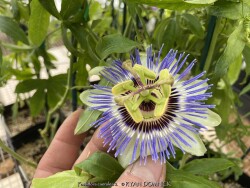

***Description for this plant available with future update!*** Passiflora caerulea is also known as Blue Passionflower.
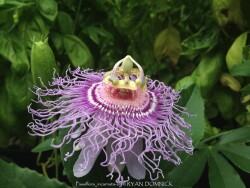

Hardy Purple Passionflower (Passiflora incarnata) is also called Maypop and is native to the eastern United States including Kansas. The plant features dark green tri-lobed leaves and tropical-looking purple and white flowers. The petals and sepals include a fringe of wavy or crimped hair-like segments with very pronounced pistils and stamens. Flowers bloom in summer and are fragrant. Fleshy, egg-shaped, edible fruits called maypops appear in July-August and mature to a yellowish color in fall. Ripened maypops can be eaten fresh off the vine or made into jelly. Maypop name refers to the loud popping sound made when fruits are stepped on. It's one of those "if you don't eat it, step on it plants"! Easily grown in a wide variety of soils including heavy clay. It is usually grown on structures that it can be easily removed from each year as it dies to the ground. We have it growing in our Lawrence, KS display garden mixed with a large patch of giant reed grass (Arundo donax) that all gets cut down each year. It weaves beautifully throughout the canes and allows for easy to harvest the fruits. Funny thing is, we did not plant it: it just showed up on its own. No other plants exist within several hundred feet! Beware that this is an extremely vigorous plant that crowds out most weeds and is itself weed-like, with a very spreading growth habit mainly from root suckers coming up freely. Best planted in wild areas where it can mix with other plants; mowing around it generally stops the yearly spread in lawn areas. Spot spraying errant shoots is also effective. "Once it's there, it's there forever" plant!


***Description for this perennial available with future update!*** Penstemon cobaea is also known as Showy Beardtongue / Cobaea Beardtongue.


***Description for this perennial available with future update!***Foxglove Beardtongue / Native Penstemon, is also known as Penstemon digitalis.
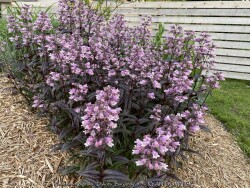

***Description for this perennial available with future update!***Dakota Burgundy Penstemon, is also known as Penstemon digitalis 'Dakota Burgundy'
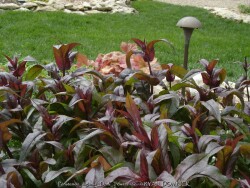

***Description for this perennial available with future update!***Dark Towers Penstemon, is also known as Penstemon digitalis 'Dark Towers'


***Description for this perennial available with future update!***Dakota Burgundy Penstemon, is also known as Penstemon digitalis 'Dakota Burgundy'


***Description for this perennial available with future update!***Large-Flowered Penstemon, is also known as Penstemon grandiflorus
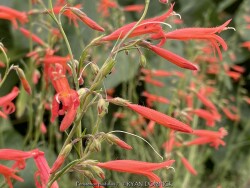

***Description for this perennial available with future update!*** Penstemon pinifolius is also known as Pine-leaf Scarlet Penstemon.
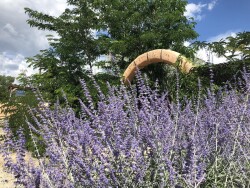

Russian sage (Perovskia atriplicifolia) is a perfectly well-adapted plant from Afghanistan, Pakistan, and Central Asia. It is the perfect match to hot Kansas summers, cold winters, rocky alkaline soils, and drought. Fine-textured foliage is upright and shrub-like consisting of a mint green to blush green color. Lavender to bluish flowers emerging in mid-summer are extremely long-lasting. In fall, Russian sage foliage dies back with the first hard freeze and becomes a whitish-gray color adding awesome winter interest. Imagine this combined with ornamental grasses or bright winter-colored plants like Color Guard Yucca. The only maintenance is cutting the plant back to you about 6 to 8 inches in the spring. New buds emerge from the root system and lower parts of the woody growth. New cultivars of Russian sage do not spread by rhizomes like the species. Russian sage thrives in dry well-drained soils with plenty of full sun and air circulation. They are suitable for hot west or south exposures, berms, parking lot islands, hell strips along roads, and other inhospitable locations. They tolerate poor soil including rock, sand, clay, and alkalinity. They do not tolerate poor drainage and will be floppy even in part shade. Russian sage flowers are highly attractive to honeybees. There are several improved cultivars with improved blooming, improved growth habit, and elimination of spreading.
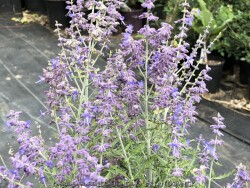

Russian sage (Perovskia atriplicifolia) is a perfectly well-adapted plant from Afghanistan, Pakistan, and Central Asia. It is the perfect match to hot Kansas summers, cold winters, rocky alkaline soils, and drought. Fine-textured foliage is upright and shrub-like consisting of a mint green to blush green color. Lavender to bluish flowers emerging in mid-summer are extremely long-lasting. In fall, Russian sage foliage dies back with the first hard freeze and becomes a whitish-gray color adding awesome winter interest. Imagine this combined with ornamental grasses or bright winter-colored plants like Color Guard Yucca. The only maintenance is cutting the plant back to you about 6 to 8 inches in the spring. New buds emerge from the root system and lower parts of the woody growth. New cultivars of Russian sage do not spread by rhizomes like the species. Russian sage thrives in dry well-drained soils with plenty of full sun and air circulation. They are suitable for hot west or south exposures, berms, parking lot islands, hell strips along roads, and other inhospitable locations. They tolerate poor soil including rock, sand, clay, and alkalinity. They do not tolerate poor drainage and will be floppy even in part shade. Russian sage flowers are highly attractive to honeybees. There are several improved cultivars with improved blooming, improved growth habit, and elimination of spreading. Blue Jean Baby Russian Sage (Perovskia atriplicifolia 'Blue Jean Baby') is a wonderful compact, non-spreading, and non-flopping variety. Lavender blue flowers held in smoky purple calyxes bloom for a long period starting in midsummer, with the color from the calyxes extending appeal into fall. Blue Jean Baby a Walters Gardens Inc. introduction.
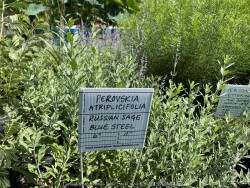

Russian sage (Perovskia atriplicifolia) is a perfectly well-adapted plant from Afghanistan, Pakistan, and Central Asia. It is the perfect match to hot Kansas summers, cold winters, rocky alkaline soils, and drought. Fine-textured foliage is upright and shrub-like consisting of a mint green to blush green color. Lavender to bluish flowers emerging in mid-summer are extremely long-lasting. In fall, Russian sage foliage dies back with the first hard freeze and becomes a whitish-gray color adding awesome winter interest. Imagine this combined with ornamental grasses or bright winter-colored plants like Color Guard Yucca. The only maintenance is cutting the plant back to you about 6 to 8 inches in the spring. New buds emerge from the root system and lower parts of the woody growth. New cultivars of Russian sage do not spread by rhizomes like the species. Russian sage thrives in dry well-drained soils with plenty of full sun and air circulation. They are suitable for hot west or south exposures, berms, parking lot islands, hell strips along roads, and other inhospitable locations. They tolerate poor soil including rock, sand, clay, and alkalinity. They do not tolerate poor drainage and will be floppy even in part shade. Russian sage flowers are highly attractive to honeybees. There are several improved cultivars with improved blooming, improved growth habit, and elimination of spreading. "Tough as steel! A new seed introduction by PanAm Seed with a sturdy, controlled habit in the landscape. 'Blue Steel' combines the best summer-blooming lavender-blue colour with outstanding late-season garden performance and has aromatic, silvery foliage carrying clouds of small blue flowers on strong silver stems that do not break or split easily. It is very hardy and Heat/drought tolerant." - PanAm Seed
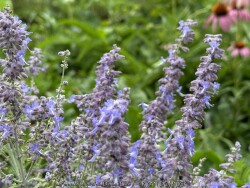

Russian sage (Perovskia atriplicifolia) is a perfectly well-adapted plant from Afghanistan, Pakistan, and Central Asia. It is the perfect match to hot Kansas summers, cold winters, rocky alkaline soils, and drought. Fine-textured foliage is upright and shrub-like consisting of a mint green to blush green color. Lavender to bluish flowers emerging in mid-summer are extremely long-lasting. In fall, Russian sage foliage dies back with the first hard freeze and becomes a whitish-gray color adding awesome winter interest. Imagine this combined with ornamental grasses or bright winter-colored plants like Color Guard Yucca. The only maintenance is cutting the plant back to you about 6 to 8 inches in the spring. New buds emerge from the root system and lower parts of the woody growth. New cultivars of Russian sage do not spread by rhizomes like the species. Russian sage thrives in dry well-drained soils with plenty of full sun and air circulation. They are suitable for hot west or south exposures, berms, parking lot islands, hell strips along roads, and other inhospitable locations. They tolerate poor soil including rock, sand, clay, and alkalinity. They do not tolerate poor drainage and will be floppy even in part shade. Russian sage flowers are highly attractive to honeybees. There are several improved cultivars with improved blooming, improved growth habit, and elimination of spreading. Denim 'n Lace Russian Sage(Perovskia atriplicifolia 'Denim 'n Lace') is a wonderful non-spreading, non-flopping variety. This is the perfect addition to a garden in hot, dry areas. Lacy-like, bright sky blue flowers are held on amethyst calyxes, with strong stems and an upright habit. The beautiful color will last a long time! All Proven Winners® plants are legally propagated, healthy and vigorous, true to name, and tagged with color pictures and growing information.


***Description for this water plant available with future update!*** Petasites japonicus is also known as Butterbur / Petasites >>>>>This plant is usually grown as a bog plant needing constantly moist soil rich in organic matter. As a rain garden plant, it will thrive is a depressed area in the landscape that collects rain water from a roof during spring and summer periods of rain but then go dormant if the water hole dries out completely. For the home garden, the species is generally too aggressive to mix with other plants
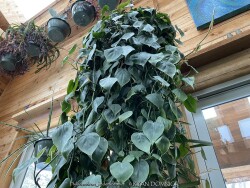

***Description for this plant available with future update!*** Philodendron hederaceum is also known as Heart-leaf Philodendron (Tropical).
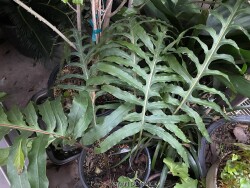

***Description for this plant available with future update!*** Phlebodium / Polypodium pseudoaureum is also known as Rabbits Foot Fern (Tropical).


***Description for this perennial available with future update!*** Phlox divaricata is also known as Woodland Phlox.
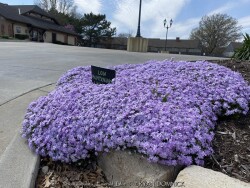

***Description for this perennial available with future update!***Blue Creeping Phlox, is also known as Phlox subulata 'Emerald Blue'
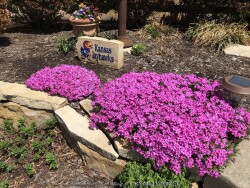

***Description for this perennial available with future update!***Red Creeping Phlox, is also known as Phlox subulata 'Red Wing'
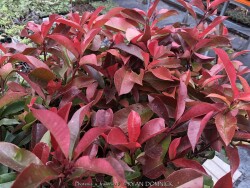

***Shrub descriptions available with future update!*** Photenia x fraserii is also known as Fraser's Photenia >>>>>>>>>>>>Repeated or successive cold winters with complete foliage loss seem to be an issue with this and many evergreen zone 6/7 plants. One occasional difficult winter followed by mild winters is more tolerable. This is, however, a very vigorous growing plant so generally will recover in one summer with decent watering and fertilizer.


***Shrub descriptions available with future update!*** Photenia x fraserii 'Pink Marble' is also known as Pink Marble Variegated Photenia >>>>>>>>>>>>Repeated or successive cold winters with complete foliage loss seem to be an issue with this and many evergreen zone 6/7 plants. One occasional difficult winter followed by mild winters is more tolerable. This is, however, a very vigorous growing plant so generally will recover in one summer with decent watering and fertilizer.
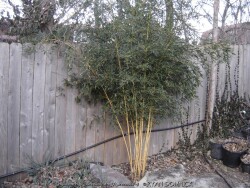

Golden Crookstem Evergreen Bamboo (Phyllostachys aureosulcata 'Aureocaulis') is a cold hardy running bamboo with a distinctive yellow culms. When planted where direct sun can shine on the culms from the south or west, they often develop a bright magenta highlight for a few weeks in the spring. Established bamboo groves provide a beautiful evergreen privacy screen. It provides ultimate wind protection, noise and traffic screening, and a hedge-like barrier. Bamboo is loved for its tropical lush appearance and a proven performance record in cold climates. It offers the only option for dry shade situations that stays green all winter. Bamboo is a great bird and wildlife shelter. You may also create trails through the bamboo grove for kids to play and built forts. Bamboo shoots 1" diameter plus are edible and quite tasty if harvested when under 6" tall and husked like corn. Timber species can obtain a maximum height of 15 to 20 feet may be achieved in 5 to 10 years. Realistic height of 10-15 feet should be expected in Kansas ( zones 5-6 ). Foliage is evergreen to 0 to 5 degrees F. Canes will defoliate at -5 to -10 degrees F. Canes die to the ground at -10 to -15 degrees. Root system will survive up to -25 to -30 degrees F as a perennial especially if mulched. Every few years a grove will experience complete winterkill: it is strongly advised to cut all dead growth to the ground for aesthetic reasons and and fire prevention. In the year after a complete winter-kill event, new growth will only grow back 1/2 as tall as it was before. It is speculated that after loosing all that foliage and biomass, it is only growing with 1/2 as much energy as before and with loss of potential photosynthesis for months in the spring before it is warm enough for new shoots to emerge. In our trial gardens in Lawrence, KS (zone 6a), all plants were killed to the ground but rhizomes survived with new growth by May. During this arctic blast of February, 2021, lows down to -17 degrees F on Feb 16th, 2021 were recorded. The longevity of this cold blast was also impressive: 10 days on a row with highs of 10-15 degrees F or lower, 8 nights of lows in the single digits and negatives, and 36 strait hours of 0 degrees F and mostly lower. As with any running bamboo, it is important to consider future spread. Spread can be controlled in lawn or forested areas by mowing at least twice a month during the months of May, June, and July and once in September. Another method of spread used mainly in China today is the shallow 12" deep sand-filled trench. Every summer, just run a shovel through the trench a few times to sever any escaping rhizomes. Also use this method for easy propagation. To keep bamboo from spreading into other landscape or formal lawn areas, you must install a continuous border around the grove. 14"-16" deep edging is needed for loamy to clay soils; 18-24" deep border is needed for sandy soils. An effective edging material is high-density polyethylene plastic professional rhizome barrier with lots of information available on proper installation techniques.
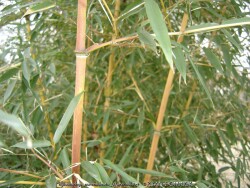

Lama Temple Crookstem Evergreen Bamboo (Phyllostachys aureosulcata 'Lama Temple') is a cold hardy running bamboo with a distinctive sulfur yellow culms. When planted where direct sun can shine on the culms from the south or west, they often develop a bright cherry-red highlight for a few weeks in the spring. Culm sheaths are more pale and pink than other bamboos. Established bamboo groves provide a beautiful evergreen privacy screen. It provides ultimate wind protection, noise and traffic screening, and a hedge-like barrier. Bamboo is loved for its tropical lush appearance and a proven performance record in cold climates. It offers the only option for dry shade situations that stays green all winter. Bamboo is a great bird and wildlife shelter. You may also create trails through the bamboo grove for kids to play and built forts. Bamboo shoots 1" diameter plus are edible and quite tasty if harvested when under 6" tall and husked like corn. Timber species can obtain a maximum height of 15 to 20 feet may be achieved in 5 to 10 years. Realistic height of 10-15 feet should be expected in Kansas ( zones 5-6 ). Foliage is evergreen to 0 to 5 degrees F. Canes will defoliate at -5 to -10 degrees F. Canes die to the ground at -10 to -15 degrees. Root system will survive up to -25 to -30 degrees F as a perennial especially if mulched. Every few years a grove will experience complete winterkill: it is strongly advised to cut all dead growth to the ground for aesthetic reasons and and fire prevention. In the year after a complete winter-kill event, new growth will only grow back 1/2 as tall as it was before. It is speculated that after loosing all that foliage and biomass, it is only growing with 1/2 as much energy as before and with loss of potential photosynthesis for months in the spring before it is warm enough for new shoots to emerge. In our trial gardens in Lawrence, KS (zone 6a), all plants were killed to the ground but rhizomes survived with new growth by May. During this arctic blast of February, 2021, lows down to -17 degrees F on Feb 16th, 2021 were recorded. The longevity of this cold blast was also impressive: 10 days on a row with highs of 10-15 degrees F or lower, 8 nights of lows in the single digits and negatives, and 36 strait hours of 0 degrees F and mostly lower. As with any running bamboo, it is important to consider future spread. Spread can be controlled in lawn or forested areas by mowing at least twice a month during the months of May, June, and July and once in September. Another method of spread used mainly in China today is the shallow 12" deep sand-filled trench. Every summer, just run a shovel through the trench a few times to sever any escaping rhizomes. Also use this method for easy propagation. To keep bamboo from spreading into other landscape or formal lawn areas, you must install a continuous border around the grove. 14"-16" deep edging is needed for loamy to clay soils; 18-24" deep border is needed for sandy soils. An effective edging material is high-density polyethylene plastic professional rhizome barrier with lots of information available on proper installation techniques.
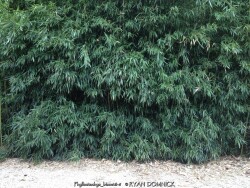

Bissett Dark Green Evergreen Bamboo (Phyllostachys bissetti) is one of the most cold hardy running bamboo there is. Foliage is bright green with dark green culms. Foliage density is very high. Established Bissett bamboo groves provide the most dense beautiful evergreen privacy screen of the cold hardy bamboos. It provides ultimate wind protection, noise and traffic screening, and a hedge-like barrier. Bamboo is loved for its tropical lush appearance and a proven performance record in cold climates. It offers the only option for dry shade situations that stays green all winter. Bamboo is a great bird and wildlife shelter. You may also create trails through the bamboo grove for kids to play and built forts. Bamboo shoots 1" diameter plus are edible and quite tasty if harvested when under 6" tall and husked like corn. Timber species can obtain a maximum height of 15 to 20 feet may be achieved in 5 to 10 years. Realistic height of 10-15 feet should be expected in Kansas ( zones 5-6 ). Foliage is evergreen to -5 to -8 degrees F. Canes will defoliate at -10 to -15 degrees F. Canes die to the ground at -15 to -20 degrees. Root system will survive up to -30 to -35 degrees F as a perennial especially if mulched. Every few years a grove will experience complete winterkill: it is strongly advised to cut all dead growth to the ground for aesthetic reasons and and fire prevention. In the year after a complete winter-kill event, new growth will only grow back 1/2 as tall as it was before. It is speculated that after loosing all that foliage and biomass, it is only growing with 1/2 as much energy as before and with loss of potential photosynthesis for months in the spring before it is warm enough for new shoots to emerge. In our trial gardens in Lawrence, KS (zone 6a), all plants were killed to the ground but rhizomes survived with new growth by May. During this arctic blast of February, 2021, lows down to -17 degrees F on Feb 16th, 2021 were recorded. The longevity of this cold blast was also impressive: 10 days on a row with highs of 10-15 degrees F or lower, 8 nights of lows in the single digits and negatives, and 36 strait hours of 0 degrees F and mostly lower. As with any running bamboo, it is important to consider future spread. Spread can be controlled in lawn or forested areas by mowing at least twice a month during the months of May, June, and July and once in September. Another method of spread used mainly in China today is the shallow 12" deep sand-filled trench. Every summer, just run a shovel through the trench a few times to sever any escaping rhizomes. Also use this method for easy propagation. To keep bamboo from spreading into other landscape or formal lawn areas, you must install a continuous border around the grove. 14"-16" deep edging is needed for loamy to clay soils; 18-24" deep border is needed for sandy soils. An effective edging material is high-density polyethylene plastic professional rhizome barrier with lots of information available on proper installation techniques.
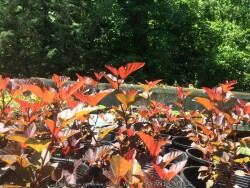

Ginger Wine® Ninebark (Physocarpus opulifolius 'Ginger Wine') expands the color palette for these easy care, native flowering shrubs. Spring foliage emerges a sunny orange color and matures to sparkling burgundy. Clusters of white flowers cover the plant in late spring, and these age to attractive red seed heads. This disease-resistant shrub does best in full sun locations and cooler climates. Top reasons to grow Ginger Wine® ninebark: 1.Colorful from spring through fall. 2. Native to North America. 3. Very low maintenance: no pruning or deadheading required. Ultra cold-hardy plants from northern climates normally dislike our long hot humid summers; although we are on the Southern edge of this plants adaptability, it still survives reasonably well here. It will not handle extreme drought; the Lawrence KS summer of 2011 and 2012 killed many plants that were not under an irrigation system. Look for a cold microclimate planting location such as East or North exposure but still in full sun. All Proven Winners® plants are legally propagated, healthy and vigorous, true to name, and tagged with color pictures and growing information.
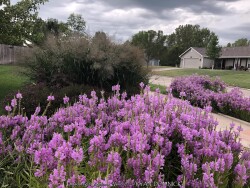

***Description for this perennial available with future update!***Vivid Purple Obedient Plant, is also known as Physostegia virginiana 'Vivid'


***Shrub descriptions available with future update!*** Picea glauca 'Conica' is also known as Dwarf Alberta Spruce >>>>>>>>>>>>Ultra cold-hardy plants from northern climates normally dislike our long hot humid summers; although we are on the Southern edge of this plants adaptability, it still survives reasonably well here. Look for a cold microclimate planting location such as East or North exposure.>>>>>
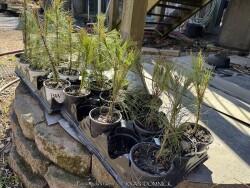

***Tree descriptions available with future update!*** Pinus rigida x taeda is also known as Pitch Loblolly Pine
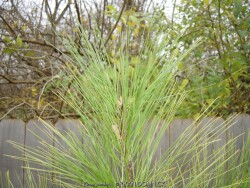

***Tree descriptions available with future update!*** Pinus taeda is also known as Loblolly Pine
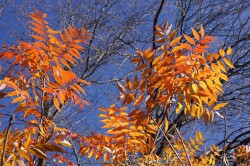

***Tree descriptions available with future update!***>>>>>In Eastern Kansas, this tree species performs WELL with just about everything nature has to challenge it! Extreme heat and drought are tolerated. Cold tolerance is no problem in our zone 6. No disease or pest problems. Great plant for berms, hot West or South exposures, and most any other garden situations in full sun. Will tolerate clay soils and extra moisture in summer. Fall color is variable in the Northern part of its range; sometimes an early frost wipes out the foliage before color can form. Interestingly, Chinese pistache is the only tree to develop fall color in the low deserts of the Southwest and as far South as Orlando, unaffected by heat and not dependant on cool night temperatures. In Stillwater, Oklahoma, chinese pistache would often hold color into December.
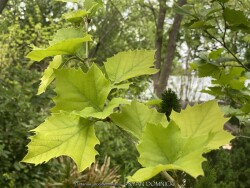

American sycamore tree (Plantanus occidentalis) is a beautiful large shade tree native to the eastern half of the United States along river banks, floodplains, and rich wooded areas. It is very easy to spot out a sycamore tree in the forest due to its attractive white peeling bark on older trees. The branching pattern is very picturesque with well shaped "U" branch intersections. The wood is coarse grained and twisted making it resistant to storm damage along with the branch angles. As a result, this tree can grow to enormous proportions. Sycamores tolerate a wide range of growing conditions but prefer moist rich deep soil and floodplains. Drought is tolerated but with a slower growth rate, otherwise growth rate is very rapid. Sycamore anthracnose is a problem during wet cold spring like weather causing trees to sustain twig and leaf damage and fill out very slowly. They almost always outgrow this by June as the weather heats up but can be an issue in the Northern part of the country. Although it's beauty is unmatched, sycamores can be messy at certain times of the year, dropping twigs, seed balls, bark strips, and large leaves. But no tree is perfect right? Sometimes Sycamore is grown for timber production. The wood is highly prized by woodworkers for it's beautiful lustrous texture when polished. Sycamore is best used if you need a decent shade tree in under 10 years but with plenty of room to mature into a large shade tree for future generations. Several improved cultivars now exist.
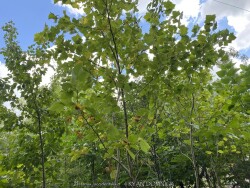

American sycamore tree (Plantanus occidentalis) is a beautiful large shade tree native to the eastern half of the United States along river banks, floodplains, and rich wooded areas. It is very easy to spot out a sycamore tree in the forest due to its attractive white peeling bark on older trees. The branching pattern is very picturesque with well shaped "U" branch intersections. The wood is coarse grained and twisted making it resistant to storm damage along with the branch angles. As a result, this tree can grow to enormous proportions. Sycamores tolerate a wide range of growing conditions but prefer moist rich deep soil and floodplains. Drought is tolerated but with a slower growth rate, otherwise growth rate is very rapid. Sycamore anthracnose is a problem during wet cold spring like weather causing trees to sustain twig and leaf damage and fill out very slowly. They almost always outgrow this by June as the weather heats up but can be an issue in the Northern part of the country. Although it's beauty is unmatched, sycamores can be messy at certain times of the year, dropping twigs, seed balls, bark strips, and large leaves. But no tree is perfect right? Sometimes Sycamore is grown for timber production. The wood is highly prized by woodworkers for it's beautiful lustrous texture when polished. Sycamore is best used if you need a decent shade tree in under 10 years but with plenty of room to mature into a large shade tree for future generations. Several improved cultivars now exist. Silverwoodtm Sycamore is a new introduction from Greenleaf Nursery in their Garden Debut® Collection. It features beautiful white bark and excellent branching. The thick, stiff leaves are bright green in summer and turn a bright golden-yellow in Autumn.


***Tree descriptions available with future update!*** Plantanus x acerifolia is also known as London Plane Tree
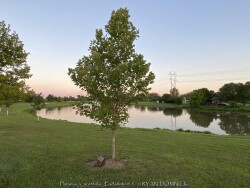

***Tree descriptions available with future update!*** Plantanus x acerifolia 'Rockford Road' is also known as Rockford Road London Plane Tree